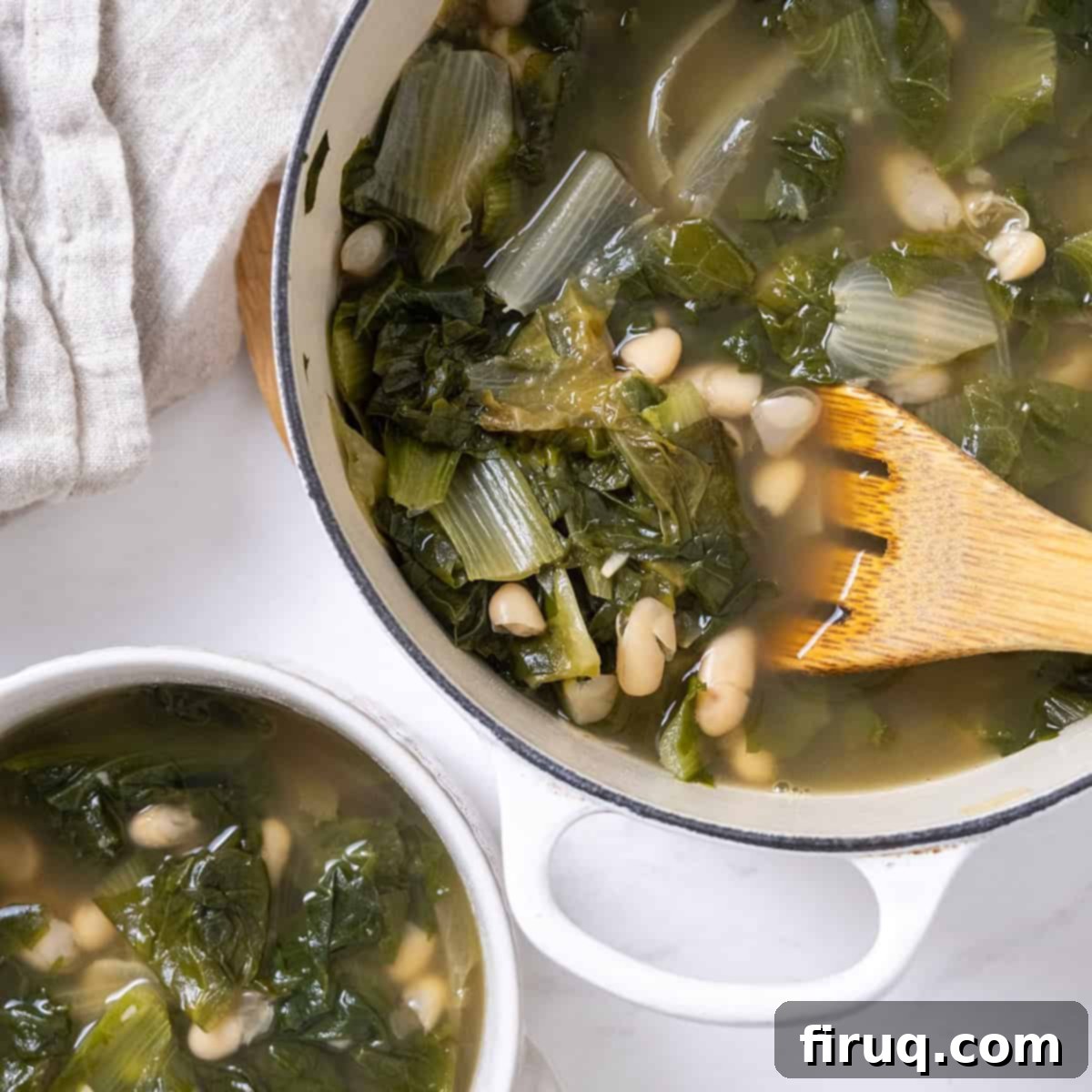Authentic Italian Escarole and Bean Soup: A Simple, Heartwarming Family Recipe
Step into the heart of Italian-American comfort food with this incredibly simple yet profoundly delicious Escarole and Bean Soup. This isn’t just any recipe; it’s a cherished legacy from my grandmother’s kitchen, a true New York Italian staple she lovingly prepared for our family throughout the chilly winter months. The robust flavors of tender escarole, hearty cannellini beans, and fragrant garlic simmered to perfection create a wholesome, satisfying meal that truly warms both body and soul. This recipe embodies the essence of traditional Italian cooking – using fresh, straightforward ingredients to create something truly extraordinary and deeply comforting.
While this soup is wonderfully fulfilling on its own, it pairs beautifully with a crusty slice of Italian bread, perfect for soaking up every last drop of the savory broth. For the ultimate nostalgic soup and sandwich experience, serve it alongside a gourmet Gruyere Grilled Cheese. This classic combination transforms a simple dinner into an unforgettable culinary delight, reminiscent of cozy family gatherings and cherished traditions. Whether you’re seeking a light lunch or a fulfilling dinner, this Escarole and Bean Soup is an accessible, flavorful, and incredibly rewarding choice for any home cook looking to bring a taste of Italy to their table.
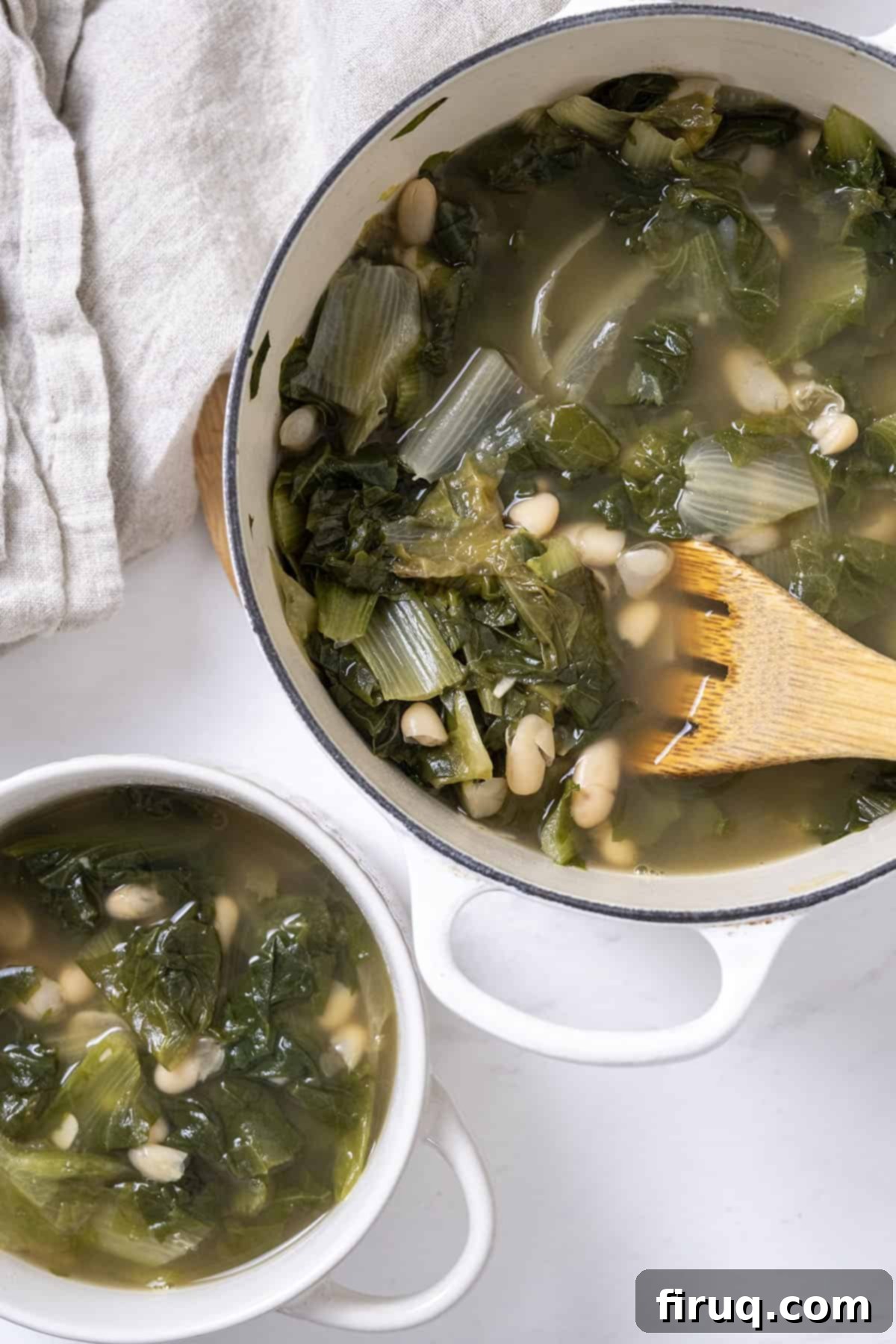
If you’re eager to explore more delightful and hearty Italian soups that evoke the same sense of tradition and comfort as this one, be sure to delve into our collection of authentic recipes. We highly recommend trying our White Bean Lentil Soup for another nutritious legume-based option, the timeless Classic Italian Minestrone packed with garden-fresh vegetables, or the incredibly flavorful Zuppa Toscana for a rich and creamy, savory experience. Each recipe brings its unique Italian flair and heartwarming qualities to your table, perfect for warming up on a cold day or sharing with loved ones.
Why You’ll Adore This Escarole and Bean Soup
This traditional Italian Escarole and Bean Soup isn’t just a meal; it’s an experience. Here’s why this recipe will quickly become a cherished favorite in your home:
- Uncomplicated Comfort: True to Italian nonna style, this soup relies on simple, wholesome ingredients and straightforward steps. It proves that you don’t need a complicated list of components to create profoundly delicious and satisfying food.
- Nutrient-Packed Goodness: Escarole offers a fantastic boost of vitamins and fiber, while cannellini beans provide essential protein and complex carbohydrates, making this a wonderfully nutritious and balanced meal. It’s hearty without being heavy, leaving you feeling comfortably full.
- Budget-Friendly: Made with pantry staples like canned beans and broth, along with readily available fresh escarole, this soup is incredibly economical. It’s perfect for feeding a family or batch-cooking for the week without breaking the bank.
- Deep, Authentic Flavors: The slow simmering process allows the garlic, escarole, and parmesan rind (a secret weapon for depth!) to meld together, creating a rich, savory broth with just a hint of pleasant bitterness from the escarole, which is beautifully balanced by the creamy beans.
- Versatile and Adaptable: While perfect as is, this soup is also a fantastic base for customization. You can easily add a pinch of red pepper flakes for heat, a squeeze of lemon juice for brightness, or even a small amount of pasta to make it even more substantial.
[feast_advanced_jump_to]
Unraveling the Mystery: How to Pronounce Escarole
In many Italian-American households, certain culinary terms are spoken frequently but rarely seen in print. Escarole was precisely one of those words for me. Growing up in a vibrant Italian-American family, I heard it often as my grandmother talked about her cooking, but its proper spelling and pronunciation remained a charming mystery. It wasn’t until I embarked on my graduate studies and started calling my grandmother more frequently for her priceless culinary wisdom that I truly started to connect the dots between the spoken word and its written form. Whether I was asking for her famous Escarole and Bean Soup, the vibrant Sautéed Rapini with Garlic, the intricate Italian Stuffed Artichokes, or the perfectly crispy Italian Chicken Cutlets, she was my living, breathing culinary encyclopedia.
One memorable occasion, when I asked her for the step-by-step instructions to make this very escarole and bean soup, she rattled off the ingredients with her usual confident flair. She told me to get cannellini beans, chicken broth, garlic, and what she lovingly pronounced as the “shkadol.” Armed with this phonetic knowledge, I confidently headed to the supermarket, searching every aisle for this elusive “shkadol,” but to no avail. After a thorough but fruitless search, I finally approached a kind worker in the produce section and, with a hopeful yet slightly embarrassed tone, inquired, “Excuse me, where do you keep the *shkadole*?” He gave me a puzzled look, asking me to repeat myself not once, but twice, before his eyes finally lit up with recognition. “Oh,” he exclaimed with a chuckle, “you mean **escarole**!” And that, my friends, is how I learned the correct, traditional pronunciation: **eh-ska-role**. It’s a charming anecdote that highlights the rich oral tradition of Italian-American cooking and the delightful quirks of regional dialects, proving that sometimes, the best lessons come with a side of laughter and a culinary quest.
Ingredient Notes and Smart Substitutions for Your Soup
Crafting the perfect Escarole and Bean Soup starts with understanding your ingredients. While this recipe is incredibly forgiving, these notes will help you achieve the most authentic and flavorful results, along with some smart substitutions for flexibility.
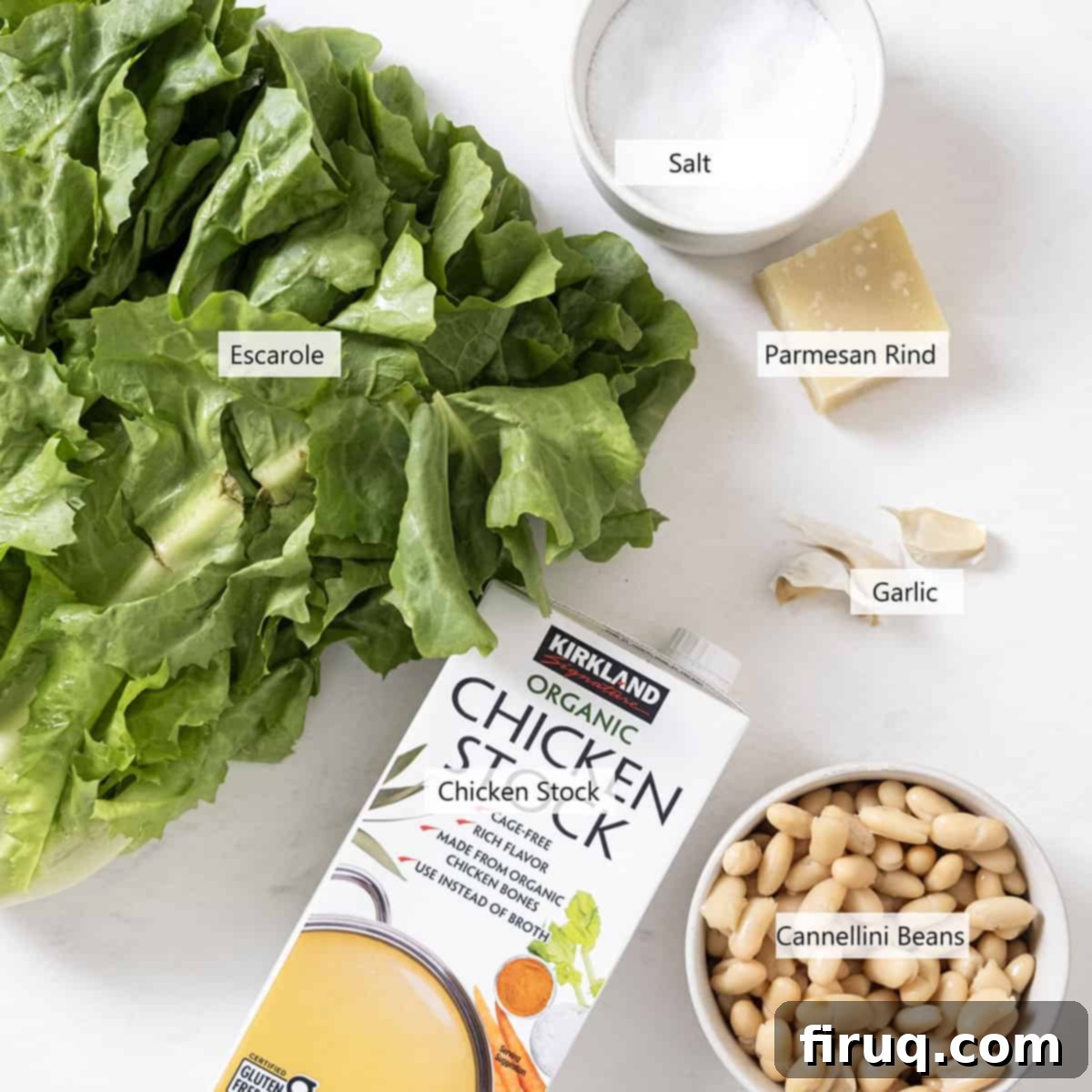
- Cannellini Beans: These classic white kidney beans are a cornerstone of Italian cuisine, beloved for their creamy texture and mild, slightly nutty flavor. They hold their shape exceptionally well during simmering, making them ideal for soups where you want distinct, tender beans rather than a mushy consistency. While they are highly recommended for their authentic touch, you can substitute them with other white beans like great northern beans or navy beans. Just be aware that some varieties might break down a bit more, creating a slightly thicker soup.
- Parmesan Rind: This might seem like an odd addition, but trust me, it’s a game-changer! The hard, flavorful rind of a good quality Parmesan cheese (Parmigiano-Reggiano if possible) slowly releases umami-rich notes into the broth as it simmers, adding incredible depth and complexity that elevates the entire soup. It’s not a necessity, but it’s a traditional Italian secret for a reason. I often add a parmesan rind to many of my soups, including Rustic Italian Tortellini Soup with Sausage and Italian Wedding Soup, for that extra layer of savory deliciousness.
- Escarole: The star of the show! When selecting escarole, look for a broad-leafed variety, as shown in the image above, rather than a curly endive. Escarole has a slightly bitter edge that mellows beautifully with cooking, adding a unique, refreshing counterpoint to the richness of the beans and broth. Ensure you wash it thoroughly to remove any grit or soil. If you absolutely cannot find escarole, a combination of mild spinach and a small amount of curly endive could be a distant substitute, but the flavor profile will be noticeably different.
- Garlic: Fresh garlic is non-negotiable for this recipe. It forms the aromatic foundation of the soup, providing a warm, savory base. Slice it thinly to ensure it cooks evenly and infuses the olive oil perfectly.
- Chicken Broth or Vegetable Stock: A good quality broth or stock is essential as it makes up the bulk of your soup’s liquid. Choose a low-sodium option to control the seasoning yourself. For a vegetarian or vegan version, vegetable stock is an excellent choice.
- Olive Oil: Use a good quality extra virgin olive oil. It’s not just a cooking fat; it contributes significantly to the Mediterranean flavor profile of this soup. It’s used to gently sauté the garlic and start the flavor building process.
*Please see the recipe card below for more detailed information about exact ingredient quantities and measurements.
Grandma’s Way: Easy Step-by-Step Directions
The beauty of my grandma’s cooking was its intuitive nature. She didn’t rely on a recipe book with meticulously measured ingredients or written instructions. Most of the delicious meals she prepared for dinner came directly from her head, a culinary wisdom passed down through generations. This meant that if you called her for a recipe on a Wednesday, it might sound a little different than if you asked on a Friday. But through careful observation and many phone calls, I believe I’ve captured the essence and the core steps of her beloved Escarole and Bean Soup, ensuring you can recreate its magic at home with ease.
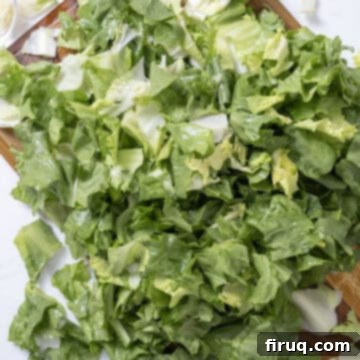
Step 1: Prepare the Aromatics and Greens. Begin by thinly slicing the garlic cloves. Aim for even slices to ensure they cook uniformly. Next, carefully wash the head of escarole under cold running water, separating the leaves to remove any hidden dirt or grit. Dry it thoroughly, then roughly chop it into 1-2 inch pieces. Don’t worry about perfection here; rustic cuts are part of the charm of this homely soup.

Step 2: Sauté the Garlic. In a heavy-bottom pot or Dutch oven, heat the olive oil over medium heat. Once the olive oil is shimmering and slightly fragrant, add in your sliced garlic. Stir constantly for 1-2 minutes until the edges of the garlic begin to turn a light golden brown. Be vigilant here; garlic can burn quickly, and burnt garlic will impart a bitter flavor to your soup. You want it fragrant and just starting to caramelize, releasing its sweet and pungent aromas into the oil.
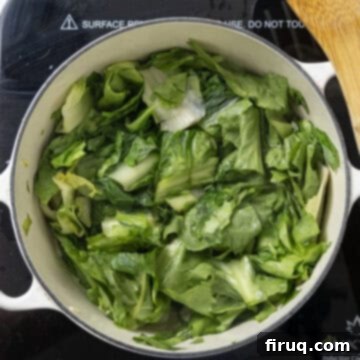
Step 3: Wilt the Escarole. Carefully add all the chopped escarole to the pot. It will seem like a lot at first, but don’t worry, it will cook down significantly. Stir it well to coat the leaves with the garlic-infused olive oil. Then, cover the pot and let the escarole wilt down slightly for 4-5 minutes. This step helps to soften the greens and reduce their volume, making it easier to incorporate into the soup base and mellowing their natural bitterness.
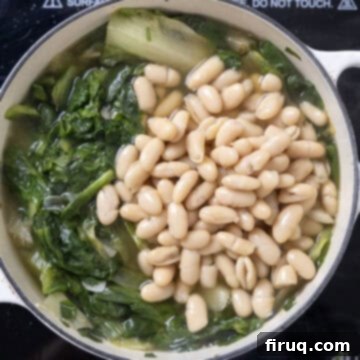
Step 4: Simmer and Infuse. Season the wilted escarole with salt to taste and stir well. Now, pour in the chicken broth or vegetable stock and add the parmesan rind. Bring the broth to a gentle simmer, then stir in the rinsed cannellini beans. Allow the soup to simmer gently for a minimum of 20 minutes to an hour. While 20 minutes will get the job done and allow the flavors to meld, simmering for a full hour will further mellow any intense bitterness from the escarole and deepen the overall savory notes of the soup. The longer it simmers, the richer and more harmonious the flavors will become, truly extracting the essence from all ingredients.
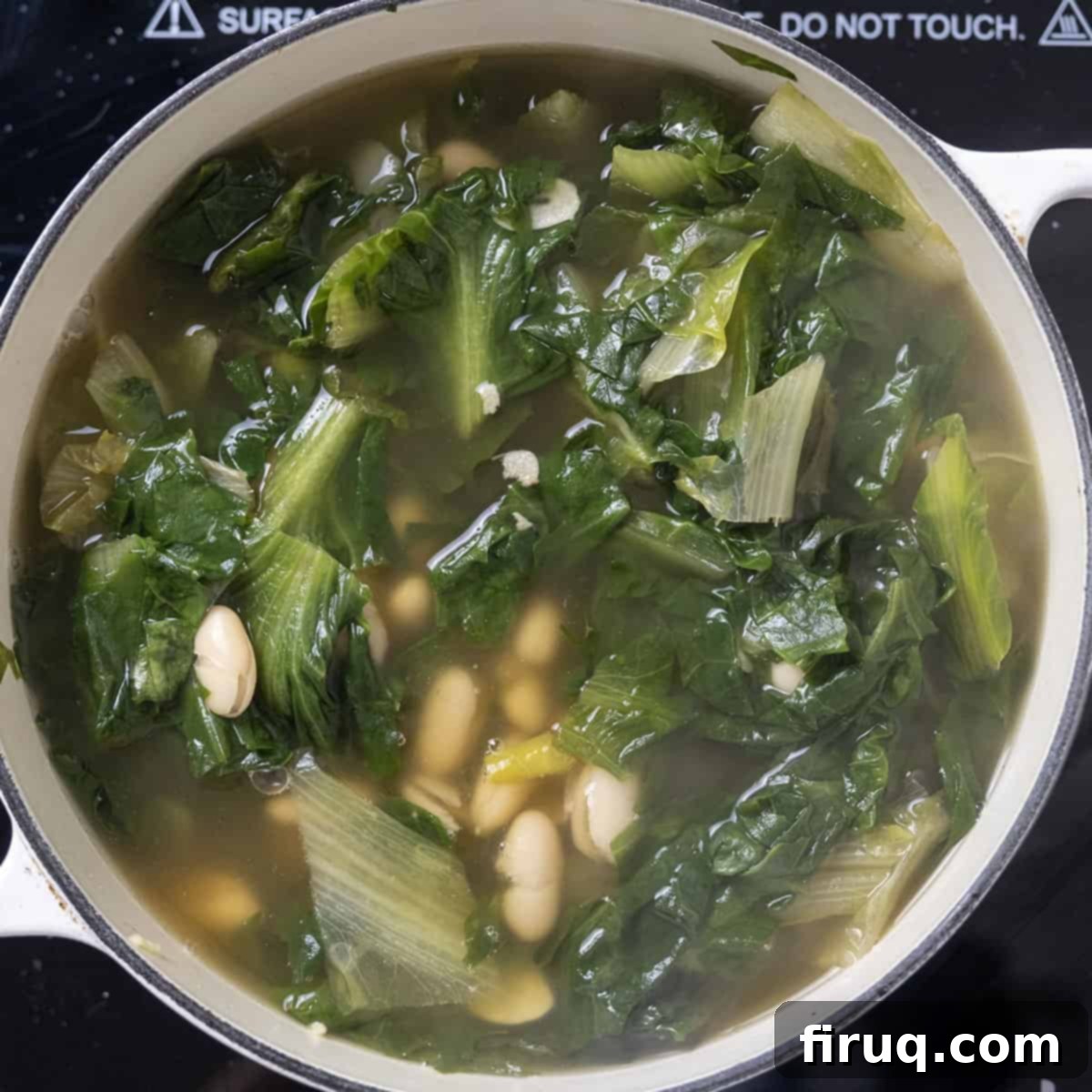
Step 5: Serve and Enjoy. Once the soup has simmered to your desired depth of flavor, remove the Escarole and Bean Soup from the heat. Carefully retrieve and discard the parmesan rind. Ladle generous portions into bowls and serve immediately. This soup is best enjoyed with some crusty Italian bread for dipping and a generous sprinkle of freshly grated parmesan cheese. For an even more indulgent and complete meal, consider serving it alongside a hearty Eggplant Parm Sandwich. The rich flavors and comforting warmth of this homemade Italian soup are sure to satisfy everyone at your table.
Pro-Tips for Perfect Escarole and Bean Soup
Elevate your Escarole and Bean Soup from great to unforgettable with these insider tips and tricks, honed through generations of Italian cooking.
- Understand the Difference: Soup vs. Sauté. It’s important to note that this recipe is for a traditional soup, meant to be brothy and comforting. If you’re looking to make just sautéed escarole and beans as a side dish, which is also delicious, you would significantly cut down the broth to about ½ a cup, focusing more on a drier, garlicky sauté. Adjusting the liquid makes all the difference in the final texture and intent of the dish.
- Rinse Escarole Thoroughly – It’s Crucial! Escarole, like all leafy greens, grows directly from the dirt. Its broad, often crinkled leaves can trap a surprising amount of soil and grit. Do not skip or rush this step! Rinse the escarole under cold running water, separating the leaves, and consider soaking it in a large bowl of water for a few minutes to allow any debris to settle at the bottom. Lift the leaves out of the water (don’t drain from the top, or you’ll pour the dirt back on) and rinse again. A clean escarole ensures a pleasant eating experience without any unwelcome crunch.
- Master the Garlic Slice. Garlic is the aromatic backbone of this soup. To ensure it cooks evenly and infuses the oil without burning, slice your garlic thinly and as uniformly as possible. This prevents some pieces from burning while others remain raw. A mandoline can help achieve perfect thin slices, or simply practice with a sharp knife. When sautéing, keep a close eye on it, stirring frequently, and remove it from the heat as soon as it turns golden brown and fragrant, to prevent bitterness.
- Don’t Skimp on Quality Olive Oil. As with many simple Italian recipes, the quality of your olive oil truly makes a difference. A good extra virgin olive oil will add a fruity, peppery depth that complements the other ingredients beautifully. Think of it as another foundational flavor, not just a cooking medium.
- Taste and Adjust Seasoning. Always taste your soup before serving and adjust the salt and pepper as needed. Remember that broth, especially if it’s not low-sodium, already contains salt, as does the parmesan rind. Start with a conservative amount of salt and add more gradually until the flavors sing. A pinch of red pepper flakes can also add a subtle warmth if you enjoy a little heat.
- Embrace the Simmer. The longer simmer time (up to an hour) truly allows the flavors to deepen and the escarole’s bitterness to mellow, creating a more harmonious and complex soup. If you have the time, let it gently bubble away, enriching itself with every minute.
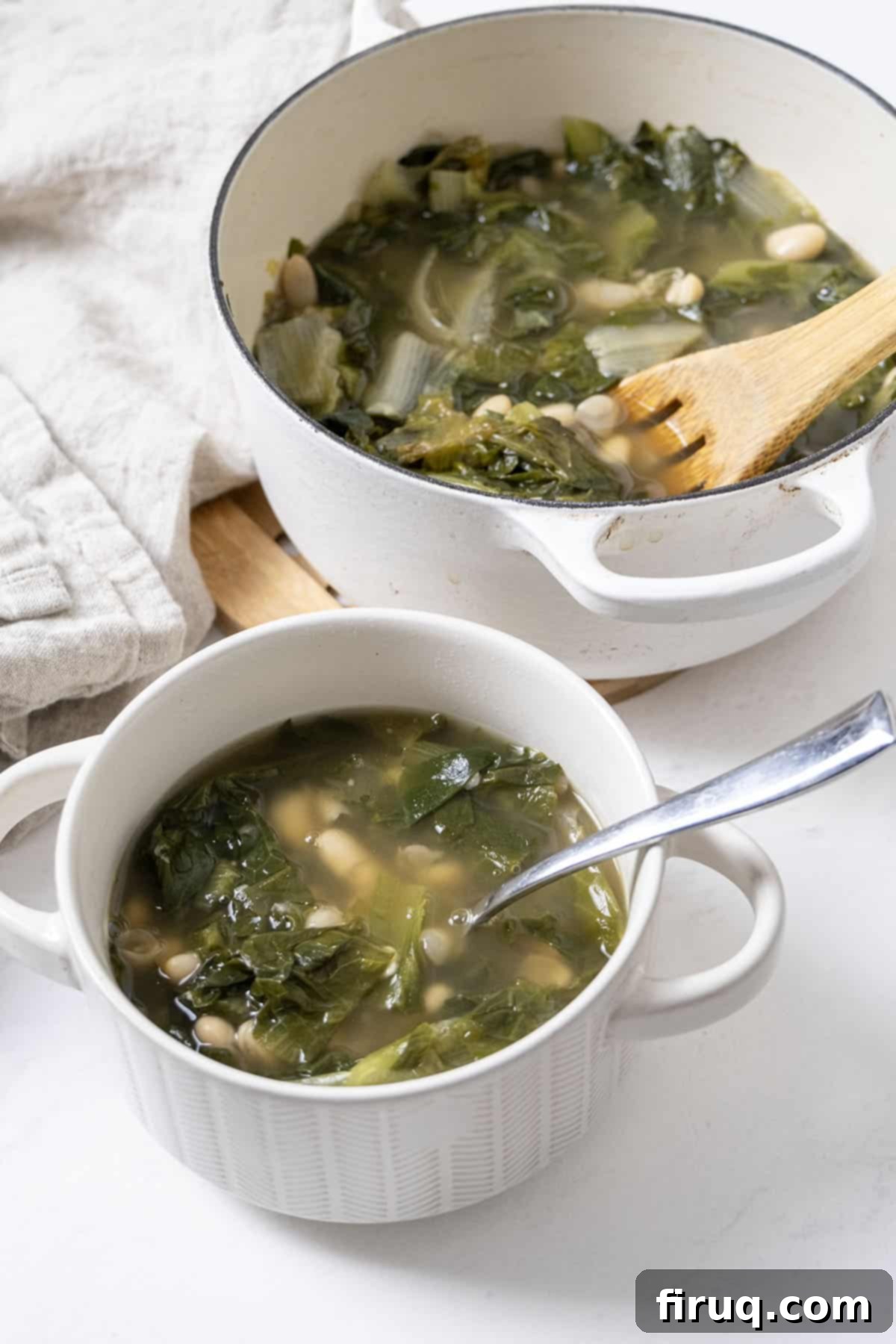
Escarole and Bean Soup: Your Questions Answered
Escarole is typically located in the produce section of your grocery store, usually alongside other leafy greens like lettuce and kale. When you’re looking for it, keep in mind that it’s sometimes mistakenly labeled as endive. The key is to select the variety with broad, flat, slightly crinkled leaves, as opposed to the tightly packed, more pointed heads of Belgian endive or curly endive, which has very frilly leaves. If in doubt, ask a produce associate for “escarole” or “broad-leafed endive.”
To maintain its freshness and flavor, store any leftover escarole and bean soup in an airtight container in the refrigerator for up to 3-4 days. When you’re ready to enjoy it again, the best method for reheating is gently on the stove. Transfer the desired portion to a small pot and heat over medium-low heat, stirring occasionally, until it’s warmed through. You might need to add a splash of extra broth or water if the soup has thickened too much in the fridge. Avoid reheating in the microwave if possible, as it can sometimes alter the texture of the escarole.
Escarole naturally has a pleasant, slightly bitter flavor, which is a key characteristic of this soup. However, if you find it too intense, there are a few tricks. The primary method is to simply let the soup simmer longer. The longer the escarole cooks, the more its bitterness mellows. Aim for a simmer of at least 45 minutes to an hour for the best results. Additionally, thoroughly washing the escarole and adding a parmesan rind to the broth helps to balance and round out the flavors, creating a more harmonious taste profile. A squeeze of fresh lemon juice or a pinch of sugar right before serving can also subtly cut through any lingering bitterness, enhancing the overall brightness of the soup.
More Heartwarming Soups for Chilly Days
If this Escarole and Bean Soup has whetted your appetite for comforting, hearty meals perfect for warding off the cold, you’re in luck! We have a delightful selection of other robust soups that are just as satisfying and flavorful. Explore these fantastic options to keep you warm and nourished:
- Barley Lentil Soup
- Rustic Italian Tortellini Soup with Sausage
- Italian Wedding Soup
- EASY Chicken Farro Soup
We hope you love this authentic Escarole and Bean Soup recipe as much as our family does. It’s a true taste of tradition, passed down with love. Please leave a comment and a star rating below in the recipe card if you try it! Your feedback means the world to us and helps other home cooks discover these wonderful flavors. Feel free to share your creations and tag us on Instagram @vindelgiudice – we’d love to see your delicious results!
📖 Recipe
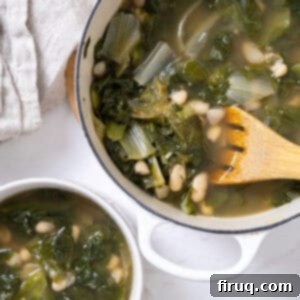
Escarole and Bean Soup
Vincent DelGiudice
Pin Recipe
Equipment
-
1 medium dutch oven
Ingredients
- 3 cloves garlic, sliced
- 1 head escarole, chopped
- 1 can of cannellini beans, rinsed
- 4 cups chicken broth or vegetable stock
- 1-2 teaspoon salt
- 1 parmesan rind
- 3 tablespoon olive oil
Instructions
-
In a large, heavy-bottomed pot or Dutch oven, add the olive oil and bring it to medium heat until it shimmers.
-
Add in the thinly sliced garlic and stir often for 1-2 minutes. Once the garlic becomes fragrant and just starts to turn golden brown at the edges (be careful not to burn it), add the chopped escarole. Stir vigorously to ensure the garlic is thoroughly mixed with the escarole and coated in oil. Cover the pot and let it wilt for 5 minutes, allowing the greens to soften and reduce in volume. Then, stir in the salt to season the escarole.
-
Pour in the 4 cups of chicken broth or vegetable stock and bring the mixture to a gentle simmer. Add the parmesan rind and the rinsed cannellini beans. Continue to simmer the soup for a minimum of 20 minutes to allow the flavors to meld. For a richer, deeper flavor profile and to further reduce any bitterness from the escarole, we recommend simmering for up to an hour. Remove from the heat, discard the parmesan rind, and serve warm with freshly grated parmesan cheese and lemon zest, if desired.
Notes
- This recipe is designed for a brothy, comforting soup, not a dry sauté. If you prefer a sautéed version, reduce the broth significantly to about ½ cup.
- Thoroughly rinse your escarole before adding it to the pot. Escarole can often harbor dirt and grit, and a good wash ensures a clean, enjoyable soup.
- To enhance the flavor, consider adding a pinch of red pepper flakes with the garlic for a subtle kick, or a squeeze of fresh lemon juice at the end for brightness.
